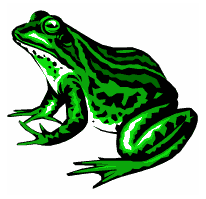
 Frogs can lay up to 4,000 eggs in one sitting! Frogs can lay up to 4,000 eggs in one sitting!
 Frog bones are a lot like trees. The bones form a growth ring every year when the frog is hibernating. Scientists can count these rings to find out the age of the frog. Frog bones are a lot like trees. The bones form a growth ring every year when the frog is hibernating. Scientists can count these rings to find out the age of the frog.
 Frogs absorb water through their skin, so they do not need to drink. Frogs absorb water through their skin, so they do not need to drink.
 Tree frogs have developed disks or suction pads on the toes of their feet to help them climb into the tree canopy. Tree frogs have developed disks or suction pads on the toes of their feet to help them climb into the tree canopy.
 Frogs can live just as well in water or on land. Frogs can live just as well in water or on land.
 Many brightly colored tropical frogs, called Dart Frogs, are colored in this way to warn predators that they are poisonous. Many brightly colored tropical frogs, called Dart Frogs, are colored in this way to warn predators that they are poisonous.
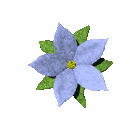
|
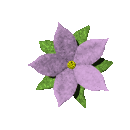
 Amphibians must shed their skin as they get bigger in size. The old skin comes off like a piece of clothing that has become too tight. Usually, this shed skin is eaten by the frog. Amphibians must shed their skin as they get bigger in size. The old skin comes off like a piece of clothing that has become too tight. Usually, this shed skin is eaten by the frog.
 Frogs have long back legs and webbed feet for jumping and swimming. Frogs have long back legs and webbed feet for jumping and swimming.
 A frog can change the color of its skin depending on its surroundings. A frog can change the color of its skin depending on its surroundings.
 Frogs use a number of ways to attract a mate, such as courtship calls, body color and limb movements. Frogs use a number of ways to attract a mate, such as courtship calls, body color and limb movements.
 Frogs range in size from 1cm to 30cm long. Frogs range in size from 1cm to 30cm long.
 Some frogs can live in environments well below freezing. The Grey tree frog, for example, can survive even though its heart stops. It does this by making its own antifreeze, which stops its body from totally freezing. Some frogs can live in environments well below freezing. The Grey tree frog, for example, can survive even though its heart stops. It does this by making its own antifreeze, which stops its body from totally freezing.
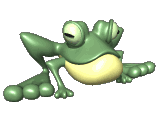
|
 The eyes and nose of a frog are on top of its head so it can breathe and see when most of its body is under water. The eyes and nose of a frog are on top of its head so it can breathe and see when most of its body is under water.
 People who study frogs and toads are called herpetologists. Herpetology is the study of amphibians and reptiles. People who study frogs and toads are called herpetologists. Herpetology is the study of amphibians and reptiles.
 Frogs eyes come in all shapes and sizes. Some even have square or heart shaped pupils. However, frogs only see in black and white. Frogs eyes come in all shapes and sizes. Some even have square or heart shaped pupils. However, frogs only see in black and white.
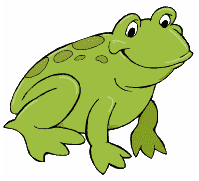
 There are more than 4,000 types of amphibians in the world! There are more than 4,000 types of amphibians in the world!
 The Golden Dart Frog is the most poisonous frog on earth. The skin of one frog could kill up to 1,000 people! The Golden Dart Frog is the most poisonous frog on earth. The skin of one frog could kill up to 1,000 people!
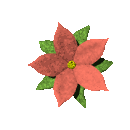
|


